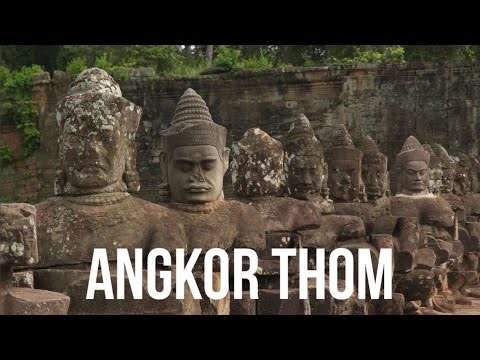(セカイの建築・再生リスト Cambodia Travel Movies List →
– HAMROC Japan & World Trip + Camera Channel –
– Wikipedia –
アンコール・トム (Angkor Thom) は、アンコール遺跡の1つでアンコール・ワット寺院の北に位置する城砦都市遺跡。12世紀後半、ジャヤーヴァルマン7世により建設されたといわれている。周囲の遺跡とともに世界遺産に登録されている。アンコールは、サンスクリット語のナガラ(都市)からでた言葉。またトムは、クメール語で「大きい」という意味。アンコール・トムは一辺3kmの堀と、ラテライトで作られた8mの高さの城壁で囲まれている。外部とは南大門、北大門、西大門、死者の門、勝利の門の5つの城門でつながっている。各城門は塔になっていて、東西南北の四面に観世音菩薩の彫刻が施されている。また門から堀を結ぶ橋の欄干には乳海攪拌を模したナーガになっている。またこのナーガを引っ張るアスラ(阿修羅)と神々の像がある。アンコール・トムの中央にバイヨン (Bayon) がある。その周囲にも象のテラスやライ王のテラス、プレア・ピトゥなどの遺跡も残っている。
Angkor Thom (Khmer: អង្គរធំ; literally: “Great City”), located in present day Cambodia, was the last and most enduring capital city of the Khmer empire. It was established in the late twelfth century by King Jayavarman VII. It covers an area of 9 km², within which are located several monuments from earlier eras as well as those established by Jayavarman and his successors. At the centre of the city is Jayavarman’s state temple, the Bayon, with the other major sites clustered around the Victory Square immediately to the north. Angkor Thom was established as the capital of Jayavarman VII’s empire, and was the centre of his massive building programme. One inscription found in the city refers to Jayavarman as the groom and the city as his bride.[2]:121 Angkor Thom seems not to be the first Khmer capital on the site, however. Yasodharapura, dating from three centuries earlier, was centred slightly further northwest, and Angkor Thom overlapped parts of it. The most notable earlier temples within the city are the former state temple of Baphuon, and Phimeanakas, which was incorporated into the Royal Palace. The Khmers did not draw any clear distinctions between Angkor Thom and Yashodharapura: even in the fourteenth century an inscription used the earlier name.[2]:138 The name of Angkor Thom—great city—was in use from the 16th century. The last temple known to have been constructed in Angkor Thom was Mangalartha, which was dedicated in 1295. Thereafter the existing structures continued to be modified from time to time, but any new creations were in perishable materials and have not survived. In the following centuries Angkor Thom remained the capital of a kingdom in decline until it was abandoned some time prior to 1609, when an early western visitor wrote of an uninhabited city, “as fantastic as the Atlantis of Plato”.[2]:140 It is believed to have sustained a population of 80,000–150,000 people.
#アンコールトム遺跡 #アンコールトム #ワット寺院


AloJapan.com